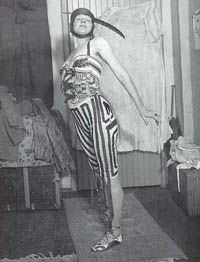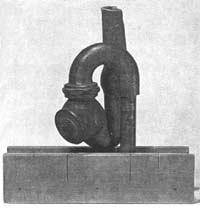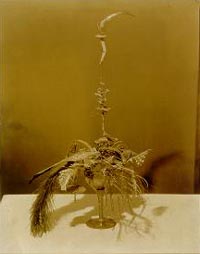Irrational Modernism
In her recent book, Irrational Modernism, Amelia Jones advances a ‘neurasthenic’ reading of the New York Dada scene, centred on the marginalised figure of the Baroness Elsa von Freytag-Loringhoven whose eccentricities, bizarre dress code and self-ostracising stench embodied and challenged the spirit of Dada. Here, Esther Leslie considers this latest revisionist gambit and asks whether it actually challenges dominant modes of history making.
 Baroness Elsa von Freytag-Loringhoven was notorious in Greenwich Village between 1913 and 1923. By all accounts - and there are several, William Carlos Williams and Djuna Barnes amongst them - she was excessive, irrepressible and smelly. She dressed in junk stolen from stores or picked from bins. She wore tea-strainers and tin cans as necklaces, a parsley-trimmed wastebasket as hat. Once she paraded a plaster penis through New York. Hers was a life led on the edge, even perhaps the edge of bohemia.
Baroness Elsa von Freytag-Loringhoven was notorious in Greenwich Village between 1913 and 1923. By all accounts - and there are several, William Carlos Williams and Djuna Barnes amongst them - she was excessive, irrepressible and smelly. She dressed in junk stolen from stores or picked from bins. She wore tea-strainers and tin cans as necklaces, a parsley-trimmed wastebasket as hat. Once she paraded a plaster penis through New York. Hers was a life led on the edge, even perhaps the edge of bohemia.
This is Amelia Jones’ argument: something about the Baroness was too much even for the self-proclaimed radicals of New York’s avant-garde. When W.C. Williams described ‘a reek’ that ‘stood out purple from her body’ or Man Ray decorated her photo with references to shit (delamerdelamerde...) their disgust was telling. According to Jones, the Baroness exposed their limits: their uptight bourgeois conventionality; the precariousness of their masculinity. Thus, Jones assimilates those ‘heroic men’ of the avant garde back into the rational bourgeois system they claimed to contest.
She does this through plumbing. Plumbing forms the context of Duchamp’s famous Dada sculpture The Fountain, and it is also the underpinning, literally, of New York’s modern urban culture. Plumbing is the rationale beneath New York’s grids, conduit of a channelling and sanitising ordering of the city’s detritus. In a further extrapolation (following Margaret Morgan’s 1990s installations), Alfred Barr’s 1936 flow diagram of the development of abstract art is described as a type of plumbing. In it, modernist movements are identified, one-way flows of influence located, and the product - art - directed towards three outflows, modern architecture or non-geometrical and geometrical abstract art. For Jones, Barr diagrammatises the (self-)containment and (self)sanitisation of the avant-garde. The Baronness cannot feature on his diagram. She is unplumbed. ‘Radically desublimated’, she shits, farts and stinks. She probably made art too - ‘God’, a twisted bit of plumbing pipe in 1917, and maybe even R Mutt’s urinal. But this ‘art’ practice - unloved till recently by any museum - is secondary to the Dada spectacle that is her life.
 > Morton Schamberg and Elsa von Freytag-Loringhoven, God, c1918..............................................................Jones’ main target is Peter Bürger, whose Theory of the Avant Garde located Duchamp’s work as a critique of ‘art as an institution’. But, counters Jones, Duchamp, along with Man Ray and Picabia, has ‘been easily recuperated into the capitalist logic of the museum’. The lived Dada of the Baroness spills out of any containment. To write about her is - and this is the crux - to challenge the settled terms of art historical enquiry, uncovering an ‘irrational modernism’, dramatised in the Baroness, but incipiently present in the Dadaists too, in their breakdowns and crack-ups. The Baroness’s existence breaks down the formalised and rationalised practices of ‘art history’s logic’, disordering and undermining art’s safeness and self-sufficiency.
> Morton Schamberg and Elsa von Freytag-Loringhoven, God, c1918..............................................................Jones’ main target is Peter Bürger, whose Theory of the Avant Garde located Duchamp’s work as a critique of ‘art as an institution’. But, counters Jones, Duchamp, along with Man Ray and Picabia, has ‘been easily recuperated into the capitalist logic of the museum’. The lived Dada of the Baroness spills out of any containment. To write about her is - and this is the crux - to challenge the settled terms of art historical enquiry, uncovering an ‘irrational modernism’, dramatised in the Baroness, but incipiently present in the Dadaists too, in their breakdowns and crack-ups. The Baroness’s existence breaks down the formalised and rationalised practices of ‘art history’s logic’, disordering and undermining art’s safeness and self-sufficiency.
Jones develops a ‘neurasthenic’ art history, tracking the excesses of her key players - their immersion in urban life, their nervous collapses caused by too frantic a participation in city intoxications and stimulations. Neurasthenia erodes the armature of the modern (artistic) personality, revealing a masculinity in crisis. It also re-humanises art history (‘leaving flesh on bones’), with tales of people, and frail ones at that (in contrast, ‘proof’ of Duchamp’s lack of radicality resides in his character traits, his supposed ‘coldness’ and ‘aloofness’.) Neurasthenic art history also re-invents the relationship between art historian and artists. Jones speaks of an art history that does not suppress identifications, a ‘Benjaminian’ ‘immersive mode of history’. Jones identifies with the Baroness, and confesses to her own neurasthenia, in its post-modern edition - ‘panic disorder’.
 > Baroness Elsa Freytag-Loringhoven, Portrait of Marcel Duchamp, c. 1918..................................................................On the book’s jacket enormous claims are made (‘the first art history of the twenty-first century’, ‘a new modernism’, ‘a new feminism’, it ‘transforms the very terms’). These claims are extravagant, and assert a model of originality and authorship this text theoretically disputes. In actuality, the book is a recycling of cultural studies’ motifs of urban modernity: Simmel’s metro-mind, flânerie and ragpicking, Chaplin as neurotic, Taylorism and space-time rationalisation. These are parsed through an intentionally complexifying Freudo-feminism, spliced with Klaus Theweleit, and spiced-up by the antics of ‘colourful characters’, in a theoretically-legitimated recuperation of gossip and biography (subjectivity). The ranks of those who have underwritten this study are legion, many commended here in footnotes. The Baroness’s stench may have banished her to the edge of the art (historical) world, but many there will hold her interpreter in good odour, as Jones buffets, again, the modernist (‘male’) avant-garde.
> Baroness Elsa Freytag-Loringhoven, Portrait of Marcel Duchamp, c. 1918..................................................................On the book’s jacket enormous claims are made (‘the first art history of the twenty-first century’, ‘a new modernism’, ‘a new feminism’, it ‘transforms the very terms’). These claims are extravagant, and assert a model of originality and authorship this text theoretically disputes. In actuality, the book is a recycling of cultural studies’ motifs of urban modernity: Simmel’s metro-mind, flânerie and ragpicking, Chaplin as neurotic, Taylorism and space-time rationalisation. These are parsed through an intentionally complexifying Freudo-feminism, spliced with Klaus Theweleit, and spiced-up by the antics of ‘colourful characters’, in a theoretically-legitimated recuperation of gossip and biography (subjectivity). The ranks of those who have underwritten this study are legion, many commended here in footnotes. The Baroness’s stench may have banished her to the edge of the art (historical) world, but many there will hold her interpreter in good odour, as Jones buffets, again, the modernist (‘male’) avant-garde.
Irrational Modernism: A Neurasthenic History of New York Dada, by Amelia Jones. The MIT Press, Cambridge MA, 2004, ISBN: 0-262-10102-5, £25.95 cloth
Mute Books Orders
For Mute Books distribution contact Anagram Books
contact@anagrambooks.com
For online purchases visit anagrambooks.com






